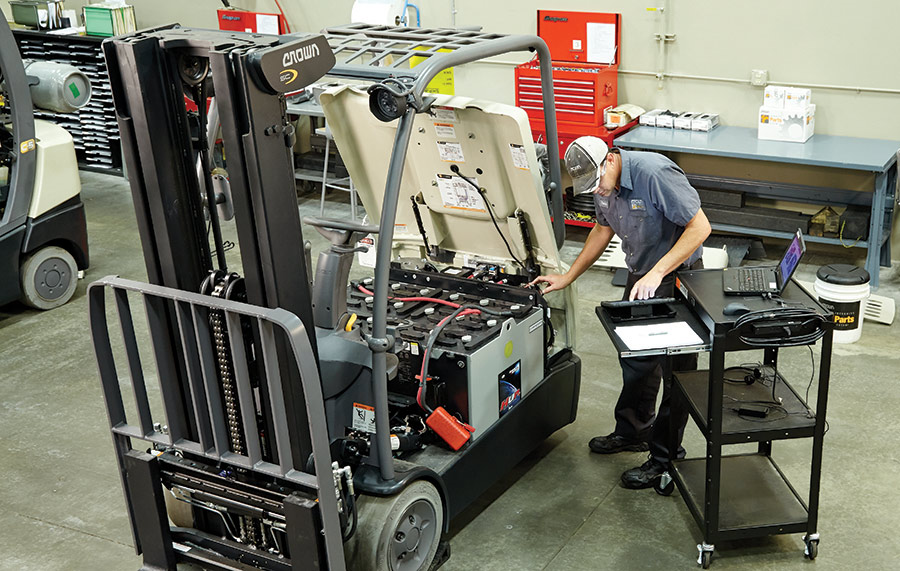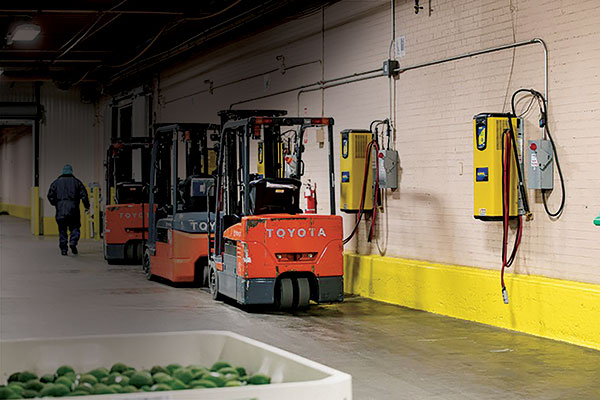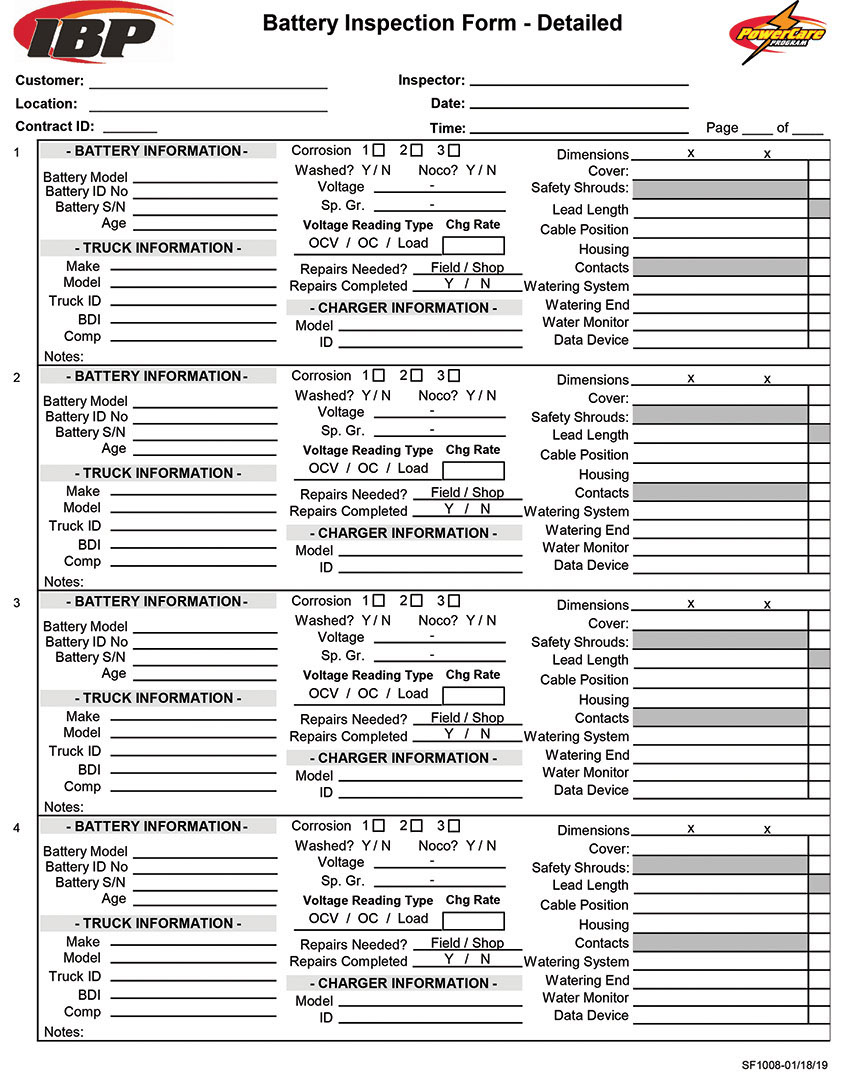Is Poor Battery Maintenance Limiting Productivity?
It's no understatement to say that lift truck battery maintenance is an after thought in most warehouses. Unfortunately, it can be a costly oversight that can hurt the most when top lift truck productivity is most needed.
Ask any expert what is at the core of successful lift truck battery maintenance and they reply with four simple steps:
- Discharge
- Recharge
- Degas
- Water
Unfortunately, for most warehouses and DCs, those four words are much easier said than done. But it doesn’t have to be that way. If you are disciplined and make those words operational habits, most common battery maintenance problems will never arise.
“The trouble is that more than 80% of operations with lift trucks have poor battery maintenance habits because they are far more focused on boxes going out the door. You have to pay attention to both,” explains Scott Barrett, Crown’s motive power manager. Sound like the last warehouse you were at?
“If you don’t, much less goes out the door when lift truck capacity is curtailed due to batteries that haven’t been charged in a timely fashion or can’t deliver maximum power when needed,” Barrett adds. Ever experienced that?
In other words, poor battery maintenance has consequences. And, it goes beyond lift truck uptime and productivity.
The standard life of lead acid batteries is cut in half without proper maintenance, explains Martin Brenneman, Toyota’s senior electric product planning specialist. Furthermore, battery warranties can be voided by suppliers if maintenance is neglected.
“Sometimes, it’s almost like companies have money to burn,” says Brian Faust, general manager of Douglas Battery.
In the end, good battery maintenance is vital to operational and lift truck productivity. “Better yet, the companies that do it well will have a competitive advantage,” says Jeff Harrison, business manager at Ametek Prestolite Power.
Your battery options
It’s worth noting that most of what’s covered in this article pertains to standard flooded (not sealed) lead acid batteries. But other options are out there.
For instance, some lead acid batteries are the low maintenance type. These typically require less general maintenance, especially less frequent watering than standard lead acid batteries.
There’s also opportunity charging. While most lead acid batteries run for eight hours without recharging, opportunity charging allows a lift truck to be recharged in brief spurts throughout the day. The battery is not removed from the lift truck, merely plugged into a charger strategically located in the warehouse when the opportunity presents itself. This typically eliminates the need for spare batteries, not to mention traditional charging rooms.
Fast charging is an option, too. Another form of opportunity charging, fast charging requires about half the time to partially re-charge a battery. It also eliminates the need for extra batteries and change-outs between shifts, reducing maintenance requirements.
Lithium ion batteries, which account for a small, but growing portion of the market, have much reduced maintenance requirements than lead acid, explains Brenneman. For instance, they do not require charging rooms and eliminate the need for spare batteries because they can be fully recharged in an hour or a little longer. Lithium ion also eliminates the need for watering, cleaning and equalizing needed by lead acid. It’s also notable that a lithium ion battery costs three to five times what a lead acid battery does.
The general rule of thumb for recharging rates for the different options is:
- 16% to 20% an hour for conventional and low-maintenance lead acid,
- 25% an hour for opportunity charging,
- 50% an hour for fast charging, and
- 100% an hour for lithium ion.
Clearly, the lift truck battery maintenance profile for your operation starts with the type of battery selected, affecting everything from recharge time to number of batteries required per lift truck.
Review your habits
“The most forgotten place in any warehouse is the charging room,” says Steve Schubring, director of sales North America for Philadelphia Scientific.
Look around at most operations, and that’s a tough one to deny. Not only are charging rooms often poorly maintained, but the operation is usually ignored. As in “not my problem.”
For those companies with attentive staff, all it takes is a promotion of one of them to put battery maintenance at risk. That may sound a little over the top, but it’s not.

Without proper battery maintenance, the standard life of lead acid batteries is cut in half.
Battery maintenance may be simple in theory but not in practice. “In my 26 plus years in this field, I’ve only seen eight or 10 operations that did a great job in battery maintenance,” says Dean Portney, vice president of sales and marketing at Hawker PowerSource.
So where do you start to build those good battery maintenance habits?
One place to being is with an assessment of batteries and lift trucks using them. The form used by Ametek (see illustration) covers everything from battery model number and age to corrosion levels and repairs needed. It also covers charger information including cable condition and watering system used. The review also matches batteries to individual lift trucks by make, model and truck ID number.
This form sets a baseline for the condition of battery maintenance in a facility. After all, four key steps need to be considered.
Take a 24-hour operation. Each lift truck requires three batteries. Going back to the four steps at the top of the story, the first battery runs an eight-hour shift and typically an 80% discharge occurs.
At the end of the shift, that lift truck brings the battery to a charging room or other designated area. The battery is removed and begins its eight-hour recharge. A second battery is inserted to the lift truck for the second shift.
Eight hours later, the lift truck returns to replace the discharged battery with a third battery. The second battery then goes into recharge mode as the first battery enters the degas cycle.
When the third shift completes, that battery goes into charging while the second shift battery starts to degas. Meanwhile, the first shift battery is reunited with the lift truck.
While this scenario is broken into eight-hour segments for ease of operation, each step actually takes fewer than a full eight hours to complete. Most operations follow the eight-hour schedule.
Finally, there is the matter of water. Typically required every week or two, watering ensures that each cell of the battery has the right amount of fluid in it to provide full power. Watering can be done manually or with an automatic watering system. The latter ensures accurate fill levels and protects workers from sulfuric acid spills, says Faust of Douglas Battery.
“What surprises me,” says Schubring of Philadelphia Scientific, “is that watering systems are used only in about 40% of operations not the 80% that they should be.” He adds that payback for automatic watering systems is two to seven months.
One other important practice is equalization, explains Portney of Hawker. The concern here, he says, is to equalize voltages in all cells in the battery. A difference in voltages is naturally caused by sulfation during charging and shortens the life of the battery. This process typically takes six hours and should be performed every 10 recharge cycles or so.
While the explanation of the process here is simple, that is not the case for operations managing tens or hundreds of batteries. To simplify that, Philadelphia Scientific has offered for years its iBos (intelligent battery organizing system). Schubring says iBos currently monitors 45,000 chargers around the world, ensuring effective battery room management.
The gritty side of maintenance
As is readily evident, traditional battery maintenance is couched in rules of thumb. Eight hours is not really eight hours but it works operationally.
For those looking for a closer monitoring of battery conditions, Ametek Insight, a Cloud-based information tool, was introduced last year, says Harrison. “It allows operators to monitor battery and charger usage for an entire fleet through continuous data collection,” he explains.
But that’s limited to monitoring battery conditions at a high level. An equally important aspect of battery maintenance gets to the nitty gritty, literally. For instance, there’s the matter of corrosion caused by improper manual watering and resulting sulfuric acid spills on the battery and floor. Those spills are a hazard to equipment and people. And all experts agree that safety is the elephant in the room here.
“If done improperly, watering can cause burns and worker comp issues not to mention destruction of personal property from clothing to rings,” explains Crown’s Barrett.
Proper handling is critical, says Toyota’s Brenneman. The company recommends protective tools such as eye and hand washing stations to protective gear when handling batteries. For the equipment, says Brenneman, rinse the battery after an overflow to prevent corrosion.
Beyond protecting people and equipment, there is the matter of maximizing battery life and power with proper maintenance practices. These include:
- frequent checks of cables and connectors for damage of any sort,
- fill battery cells to the appropriate level,
- check the specific gravity of the battery at least twice a year, and
- look for white chalky residues on the floor, a sign of overfilling batteries.
Fortunately, you are on your own here only if you choose to be. Lift truck dealers as well as equipment suppliers can help ensure that lift truck battery maintenance makes the grade at your warehouse or DC. And with so much pressure these days on moving boxes out the door, you can’t afford to leave battery maintenance to chance.
Companies mentioned in this article:

Article Topics
MRO News & Resources
Avidbots showcases autonomous cleaning robots Traka exhibits modular lockers MRO Survey: Finding and keeping the best technicians Maintenance, Repair and Operations: Understanding the true condition of the equipment Newly formed Bison combines AMETEK DFS and Bison Gear and Engineering Corp. Building (and maintaining) your maintenance, repair and operations (MRO) tech workforce The power side of lift truck battery and charger maintenance More MROLatest in Materials Handling
Beckhoff USA opens new office in Austin, Texas Manhattan Associates selects TeamViewer as partner for warehouse vision picking ASME Foundation wins grant for technical workforce development The (Not So) Secret Weapons: How Key Cabinets and Asset Management Lockers Are Changing Supply Chain Operations MODEX C-Suite Interview with Harold Vanasse: The perfect blend of automation and sustainability Consultant and industry leader John M. Hill passes on at age 86 Registration open for Pack Expo International 2024 More Materials HandlingSubscribe to Materials Handling Magazine

Find out what the world's most innovative companies are doing to improve productivity in their plants and distribution centers.
Start your FREE subscription today.
April 2024 Modern Materials Handling

Latest Resources













